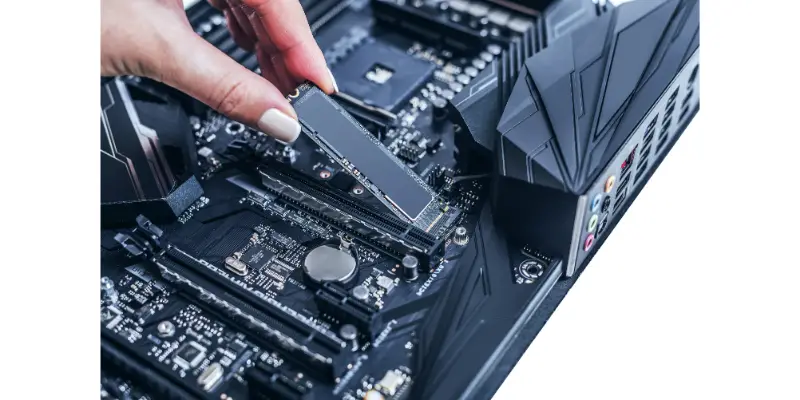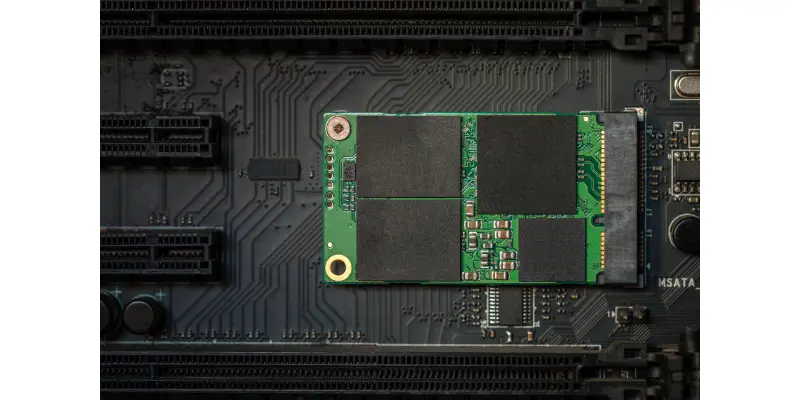Disclaimer: This post may contain affiliate links, meaning we get a small commission if you make a purchase through our links, at no cost to you. For more information, please visit our Disclaimer Page.
So you want to upgrade your HDD but you’re not sure if you can use an SSD with an old motherboard.
The compatibility between an SSD and a motherboard depends on whether or not they have the same disk interface type, such as SATA. You can use an SSD with your old motherboard if they are compatible. If the model of the old motherboard doesn’t have SATA, you need to upgrade your CPU to use SSD.
Table of Contents
Can I Use an SSD With My Old Motherboard?
Before going ahead to answer this question, let me start by talking about what an SSD is and why you need to install one on your old PC.
What exactly is an SSD?
For those who don’t know, an SSD or solid-state drive is a new generation type of storage device that the computer uses. It’s often used in place of the spinning hard disk drive (HDD).
Unlike HDD that utilizes a hard disk, the new generation SSD drive makes use of non-volatile memory. This feature makes it easy and quick for the solid-state drive to access data much faster than HDD.
Furthermore, SSDs offer tons of amazing benefits to the computer. One of its advantages over HDD is that it has no moving parts. With that, it means it’s pretty durable to drops and flexible against data loss, caused by physical factors. That’s not all; SSDs also lack a spinning metal platter and read arms. This makes them a little bit less noisy than their counterpart – HDD.
Above all, SSDs are capable of gaining access to data pretty quickly. To be precise, the new generation storage devices pack access speeds of 35 to 100 microseconds. When you compare that to the access speed of HDDs, it means the solid-state drives are about 25 to 100 times faster than hard disk drives. Here’s where the need to use an SSD with an old PC comes into play.
Back to the burning question of whether or not you can use an SSD with an old motherboard. The answer to the question, as I earlier mentioned, is yes. However, it’s worth noting that the process of installing an SSD on an old motherboard is sometimes complicated.
Here’s why
First, you need to understand that your chances of being able to use a solid-state drive with your old motherboard depend on their compatibility.
Furthermore, irrespective of what you’re using, be it a laptop or a desktop PC, one thing you need to know is that the compatibility between the solid-state drives and computers depends on whether or not they have the same disk interface type.
In case you don’t know, the SSD storage device has a few different interfaces. They include mSATA, U.2, SATA Express, SATA, and M.2. Today, SATA is the most common type of interface used by SSDs on desktop PCs. However, the M.2 interface is also common.
That said, if you’re considering using a SATA SSD with your old motherboard, you’ll need to first confirm whether the model has SATA. If not, you will find it pretty hard to use the SSD with your old motherboard.
As for M.2 SSDs, the compatibility depends on two things – interface and length. That said, for your old motherboard to be compatible with an M.2 SSD, it needs to have an M.2 interface. In addition to that, their lengths also need to be compatible – here’s why you need to know the type of protocol it supports.
How to check for motherboard & SSD compatibility?
As earlier mentioned, if you’re using a SATA SSD drive, the old motherboard needs to have SATA. Furthermore, you need to understand that the SATA interface is in three major revisions;
- SATA I (revision 1.x)
- SATA II (revision 2.x)
- SATA III (revision 3.x)
Interestingly, all three revisions are backward and forward compatible. With that, it means as long as your old motherboard has SATA, you’ll be able to use any of the three SATA SSDs with it.
As for M.2 SSDs, your old motherboard needs to have an M.2 interface. However, this alone isn’t enough. Their lengths, as earlier mentioned, also need to be compatible.
The M.2 interface has five lengths; 30mm (2230), 42mm (2242), 60mm (2260), 80mm (2280), and 110mm (22110). Sadly, not all desktops have all of them. Apart from that, it also has three different types, B key (Socket 2) and M key (Socket 3), and B&M key. Unfortunately, the B key isn’t compatible with the M key. However, you can always use the B&M key with any one of socket 2 and socket 3.
The bottom line is, you need to check both the SSD and your old motherboard to know their disk interface types. If they are compatible, then you can go ahead and install the SSD on the mainboard.
How Do I Know If My SSD Is Compatible With My Motherboard?
As earlier stated, the two common hard disk interfaces for desktop computers are SATA and M.2 SSDs. So, for you to know if your SSD and motherboard are compatible, you need to run a check to find out.
First, be sure to know the type of disk interface your SSD is using. Is it an M.2 type or a SATA type? After that, you can go ahead to check your desktop motherboard to find out the type of disk interface it supports.
There are two options to check your motherboard to know the type of interface it has. One way to do that is to open your computer and check the motherboard directly. You will certainly see the type of disk interface it uses when you do that.
Alternatively, you can always go online and check for the disk interface type on the motherboard manufacturer’s website. Of course, for you to do that, you’ll need the model name of the mainboard.
Does an SSD Work With Any Motherboard?
The answer to this question is no, an SSD cannot work with all motherboards. The best option is to check the compatibility of the drive and the mainboard first. This way, you can determine whether they’ll work together.
If, after checking the disk interface of your motherboard, you find out it only supports SATA. Does it mean an M.2 SSD won’t work with it? The answer is no. You can always use an M.2 solid-state drive with a standard SATA interface on a motherboard. Matter of fact, an M.2 drive can also work on the Peripheral Component Interconnect Express (PCIe) interface. But this sure depends on the type and functionality of the M.2 SSD you’re using.
Can You Use an Old Hard Drive on a New Motherboard?
Yes, you can always use an old hard drive on a new motherboard. However, it’s worth knowing that this can introduce a couple of challenges.
For you to avoid any issues when trying to use the old hard drive with your motherboard, you can use any of these two options:
- You need to keep the hard drive without touching your current files. To do that, you need to enter your BIOS and modify the settings, including changing the SATA configuration to IDE from AHCI. After that, you will allow the system to the relevant drivers.
- The second option requires you to reformat and install your Windows 10 again from scratch.
The bottom line is, it’s very possible to use an old drive on a new motherboard.
Conclusion
Solid-state drives are capable of gaining access to data very quickly. This is why they have an edge over the hard disk drives.
As such, if you still have an HDD installed on your PC, this is the best time to start enjoying SSD. All you need to do is to check the disk interface type of your old motherboard and use it alongside a compatible solid-state drive.


